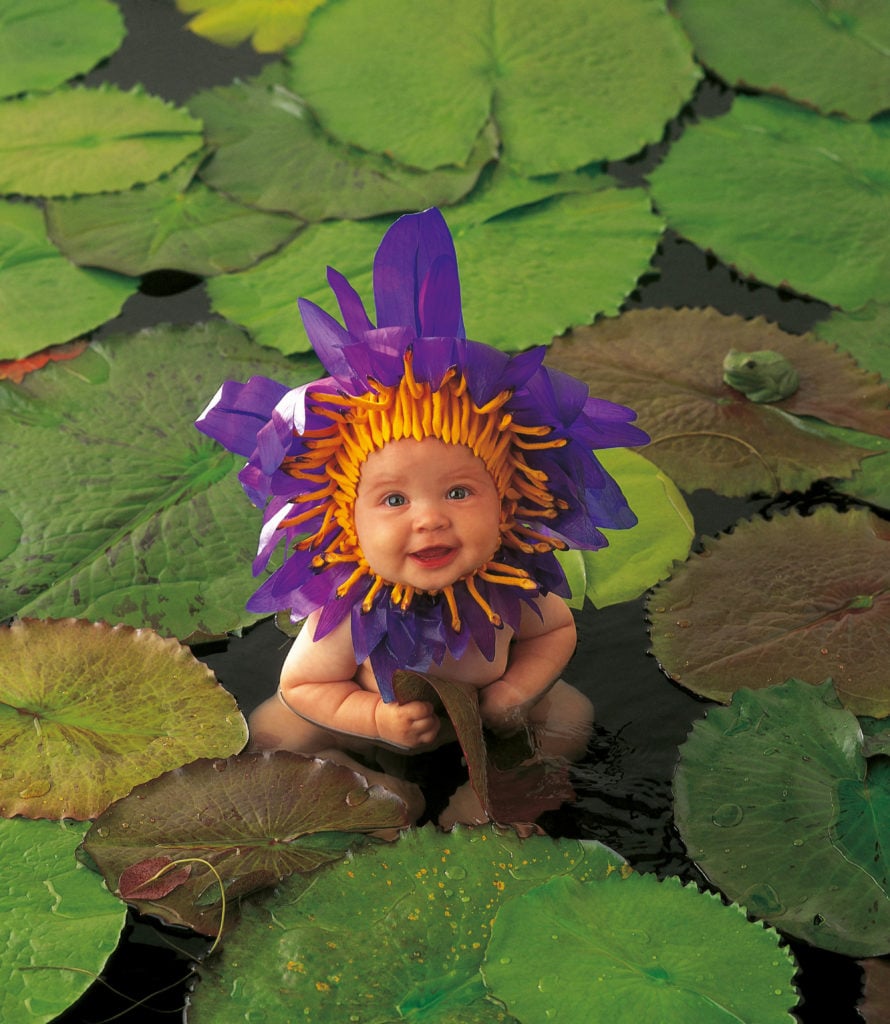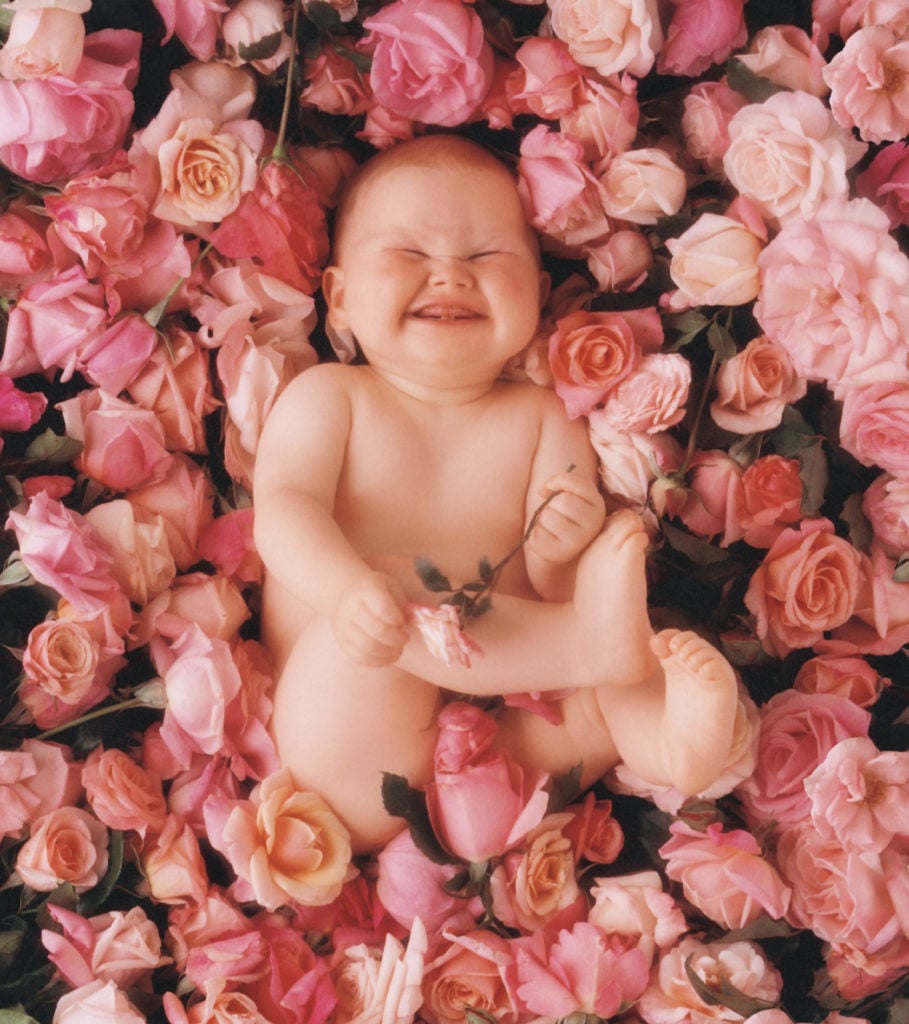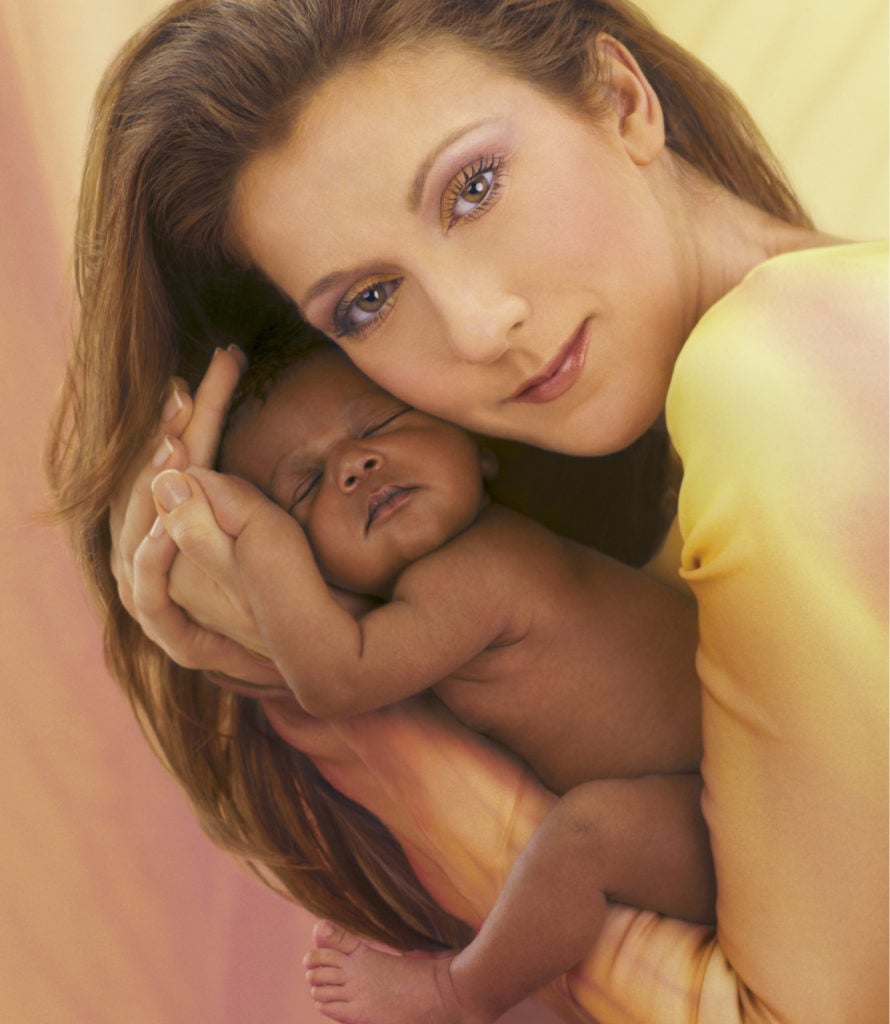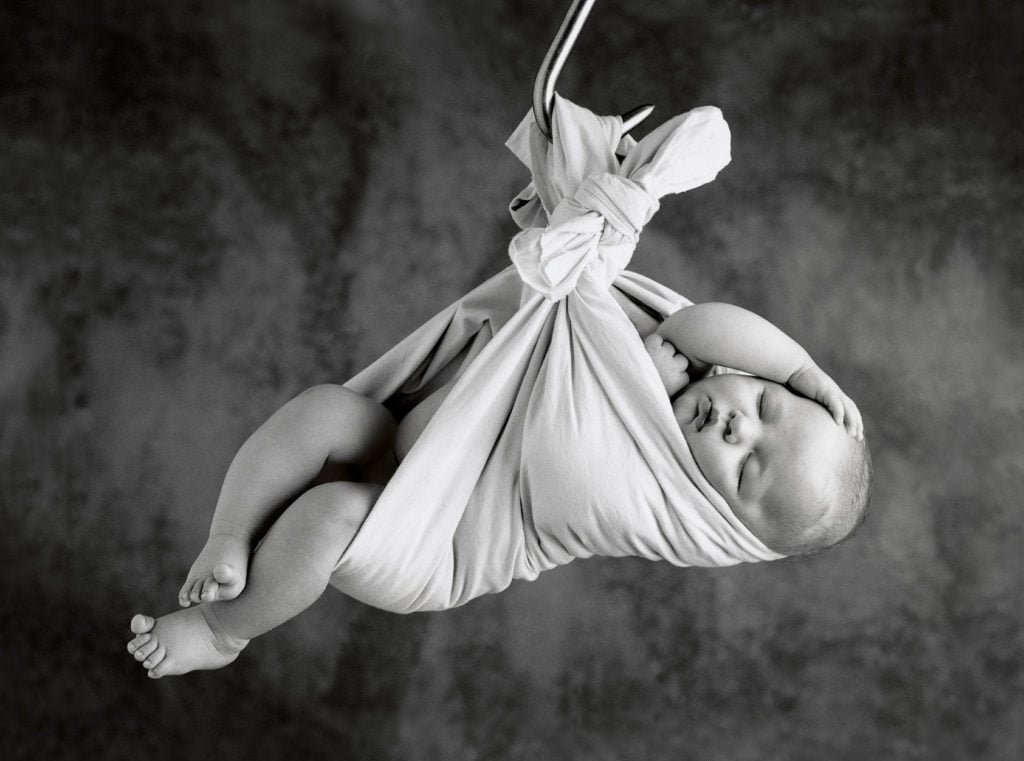People
Anne Geddes Was Once the Queen of Baby Photography. Now, She’s Hit Hard Times—and Is Asking for Your Help
The photographer spoke to Artnet News about how the rise of the internet dramatically altered the course of her career.

The photographer spoke to Artnet News about how the rise of the internet dramatically altered the course of her career.

Noor Brara

Like many famous artists, Anne Geddes both is and isn’t what you think she is, but I never could have imagined that an interview with the self-described queen of “joy spreading” would result in anything less than a walk down the yellow brick road of her memory lane, relegated mostly to talk of babies superimposed onto the heads of sunflowers. As is often the case, I was in for a rude awakening.
In truth, the industry that propelled Geddes to superstardom in the 1990s has all but evaporated. Today, the internet churns out imagery at a pace with which few photographers can compete, while email gobbled up the greeting-card industry, leaving Geddes in dire straits.
But you wouldn’t know any of this by looking at her life from the outside, as I did one evening a few weeks ago, when I unwittingly fell down the rabbit hole of her Instagram. Comatose from incessant TV-watching, I longed to rest my eyes upon something electric, something to shake me awake or at least keep me afloat. (Reader, things were getting bleak). I wanted to get lost in Geddes’s carefully crafted fantasia of costumes and childlike wonder, nostalgic for another time and place that wasn’t marked by transient internet imagery and the coronavirus.
On her feed, I found a grainy smattering of fan photography instead, featuring smiling, gurgling, laughing little offspring, sent in from India, Slovakia, Argentina, Australia. Here was Federico, a funny 14-month-old with a gummy grin, and toddler Mason, smirking from beneath a lime green Shrek mask. For each day, there was a new post of a baby from a different city featuring their name and age, alongside charmingly specific details. Collectively, they comprise “The Joy Project,” an initiative Geddes recently began to remind people that there is still good in the world—all over it, in fact.
The morning I called to talk to her about the project, she tells me that she’s got 64 countries and counting represented on her grid so far. “And it’s about to be 65,” she says. “I’m waiting on something from Lichtenstein.”
Much like the rest of us nonessential workers, Geddes spent the first weeks of March curled into a ball on the sofa, anxiety-scrolling through the headlines, and venturing outside occasionally for walks with her husband, Kel, and their dog, Ethel.
But idle hands make fretful minds, and doing nothing at all proved to be just about as stressful as the harried pace of the lives we were leading before all this happened. Geddes wanted to help others grapple with the emotional toll of their new reality, which is, in her view, a different kind of essential work. “Every day, I was reading about the workers on the front lines who are really stepping up and facing the moment with some courage,” Geddes says. “And I kept saying to Kel, ‘What can I do?’ I must be able to do something, because my name’s out there and people know me for something positive. My oldest daughter said to me, ‘Why don’t you get people to send in photographs and share some joy? And I thought, ‘Well, yes. That’s something that I’ve been doing for my nearly 35-year career.’”
She put out a call for submissions and hundreds of mothers began sending in pictures of their young ones, regaling her with stories of their own youths, a time when Geddes herself was a buzzy icon. Back then, her books fronted the staff recommendation section of every Barnes & Noble around the country, and sidled up next to expensive perfumes and cashmere sweaters on celebrity Christmas shopping lists. “There are lots of mothers with babies who’ll write me to say, ‘Oh, when I was a teenager, I would buy your greeting cards and calendars and so on,’” Geddes says. “And I respond to every single one, which I think they find surprising. I generally just say, ‘Oh hello, sweet Sterling, for instance, sending love from Auntie Anne.’ And they all send messages back to Auntie Anne. It’s really nice.”
Now, the photographer spends the early morning hours of most days sorting through these entries, deciding whose day she’ll make and which faces will get to feature alongside her own enchanting pictures, on her Instagram. To anyone looking in, life seems abundant and full, and it’s easy to conjure the image of Geddes snuggled into her sofa, reading through her fan mail, occasionally peering down from the window of her ivory tower in Tribeca. In many ways, though, it is nothing like that.

Photo courtesy Anne Geddes.
Geddes hasn’t set foot in a photo studio since 2016. Paper products, the medium by which she amassed her fortune and cemented her icon status in the late 1990s—in coffee table books, calendars, and greeting cards—have all but disappeared, leaving the photographer without reliable or regular opportunities for work. In many ways, her trajectory is a microcosm of how the broader economics of studio photography have changed over the past two decades, as the world has become increasingly more digital.
While, for many years, Geddes could leverage the royalty sales of her coffee-table books and greeting cards to both pay her bills and fund future projects, those formats no longer sell, nor are they produced nearly enough to sustain the business model she built her name upon.
The proliferation of cell phones, along with social media, has also ensured that “content”—be it a trivial meme thrown together in two minutes or a shoot like one of Geddes’s, which often takes six to eight months of planning alone—can be shared at light speed, most of the time without a thought as to where it came from.
Naturally, Geddes has become wary of promoting herself online, aware of an image’s potential to go viral on the internet and the ease with which artists can have their material co-opted. There is little financial return for new work nowadays because people, she says, expect everything to be on the internet, and everything on the internet to be free.
For a photographer who was, at one point, flown to Monaco to photograph the early years of its crown prince, it is simply not good business sense to just “go viral.”
“The thing that people don’t seem to get is that it takes about $250,000 to $350,000 to produce the kinds of shoots that I do,” she says. “It’s like doing a movie, for god’s sake. And if there’s no financial return, it’s like money out of my own pocket. Of course there are more ideas I want to do—beautiful things that I know would blow people’s minds, but what’s the point? They’d just say, ‘Thank you, Anne, that’s adorable,’ and run off with it.”
Geddes is frustrated and has no qualms about telling me so. In fact, she’ll tell anyone who wants to listen—for a monthly fee on her Patreon, the site that allows creatives to amass “patrons,” or paying subscribers, to whom they deliver exclusive content that their audience—usually superfans—wouldn’t be able to find anywhere else.
On Patreon, Geddes is candid with her patrons, expressly letting them know that the future of her career, in some ways, is in their hands. If they wish to see more “magic,” as she calls it, they must pay. In exchange, she’ll share the stories of her more iconic shoots and offer behind-the-scenes looks at her new projects. She gives budding photographers advice sometimes, too. (Geddes’s Patreon is currently paused for now while the space where she films her videos is closed due to coronavirus.)
I ask her if it ever feels icky, and if it was hard to admit that she—a household name whose career was anointed by Oprah—is more financially vulnerable now?
“It was a relief, to be honest,” she says. “I think everyone thinks I’m this global icon who owns every photograph of a baby that’s ever been produced, or that people are copying me all over the world. But that’s just not the case, and things aren’t now what they were then.”

Celine Dion. Photo courtesy of Anne Geddes.
Geddes grew up in northern Australia, with aspirations to be a sign painter. She doesn’t have a single photograph of herself as a baby. But she always loved photography, particularly the dazzling, full-page images she saw in LIFE magazine. “I used to stare at them and think, ‘That’s a moment in time that’s there forever,’” she says. “And I still think that the power of a still image far outweighs the power of a moving video.”
In the early 1990s, she began working as an assistant to a photographer who specialized in baby portraiture. While she loved shooting children, the static nature of the work became, in her words, exhausting in the way that all creative work eventually becomes when it’s not the kind you want to be doing. To give herself “a bit of a break,” she began shooting the images we’ve come to file under the Geddes signature style once a month, letting her wildest fantasies come alive.
In 1996, she published her book Down In the Garden, turning babies into beds of roses, and tucking them between the soft petals of tulips. Oprah discovered it and flew her to Chicago to appear on the show, naming the work the best coffee-table book she’d ever seen. From there, Geddes was catapulted into “the worldwide scene of being known,” and the book flew to the top of the New York Times bestseller list, where it remained for weeks. Geddes went on to appear on an episode of Friends and she shot a book with Celine Dion.
While she gamely answers my questions about the fun parts of her career, Geddes recalls them with a certain fatigue. She is quick to mention that, in addition to her frothier, arm-tickling work, her lesser-known advocacy projects done in conjunction with the nonprofit March of Dimes is equally, if not more, important to her.
“I’d like to do more of that because I find it really meaningful,” she says. “My favorite memory of shooting is a project we did in a [neonatal intensive care unit] in Doha—and whenever I shoot in the NICU, I always say I’ll never do it again, because I stick out like a sore thumb and photographers aren’t supposed to be there. But I was working on this series where I shot preemie babies with sports heroes to highlight the importance of a healthy lifestyle, and how strong they can become, and there was this famous Qatari basketball player, who played for one of the American teams. He came to the NICU to be photographed with one of the babies. He was about six-feet-eight-inches tall. And afterwards, my five-foot-two-inch producer walked him out and all of a sudden he started crying. She asked what was wrong and he said, ‘Oh my god, that’s the best thing I’ve ever done in my life.’ And really, that’s the power of new life.”

One of Geddes’s first artistic shoots. Photo courtesy of Anne Geddes.
Despite her enormous success, there have always been detractors. “You know, when I was first starting out, other photographers—mainly men—would say to me, ‘Oh, you photograph babies? I used to do that when I was first starting out,’ with the implication that your work isn’t important until you move on to bigger, more ‘serious’ subjects. But I wonder if anyone ever said to Ansel Adams, ‘When are you going to stop shooting landscapes? Take up fashion.’”
Still, she is resilient, and aware, perhaps more now than ever, of her work’s enduring resonance. “I think it’s been hugely gratifying that I’ve been able to lift babies into an art form,” Geddes says. “And their power is very honest and pure because newborns are everything to the human race. There’s no such thing as a mean-spirited baby. It’s what happens to them after that changes everything. But right at that point of newness, their little minds are so pure and I think that’s what moves even people like that athlete, who’s had all this success. They take you back to the beginning, to the beauty of new life and to the magic of it. And that’s why I think the work matters. It’s why I do what I do.”